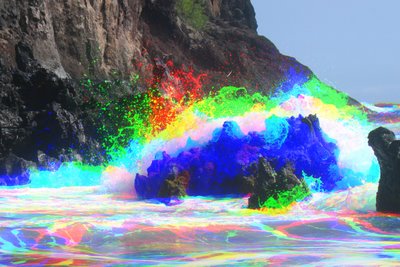Color Channel Composites
 We had the opportunity while in Hawaii to try a new technique for me. This is something I have wanted to do for years, but it was much harder to accomplish in the days of film. In those days you would achieve this look by taking three exposures on black & white film, each with a different filter. When the filters were chosen to be balanced (such as the same density of Red, Green, and Blue) you could superimpose all three images on color paper (exposed through the same filter that the image was created with) and end up with an image like the one above. Anything that did not move between images should appear in it's natural colors. Anything that did move will pick up the color of the filter.
We had the opportunity while in Hawaii to try a new technique for me. This is something I have wanted to do for years, but it was much harder to accomplish in the days of film. In those days you would achieve this look by taking three exposures on black & white film, each with a different filter. When the filters were chosen to be balanced (such as the same density of Red, Green, and Blue) you could superimpose all three images on color paper (exposed through the same filter that the image was created with) and end up with an image like the one above. Anything that did not move between images should appear in it's natural colors. Anything that did move will pick up the color of the filter.With digital it is much easier to create this image. You start with three images taken in succession, making sure that the camera does not move between exposures (such as by using a tripod). You can hand hold the exposures, but that requires additional post-capture work, shifting and rotating to make sure that all of the images line up correctly. The rest of these instructions are specific for Photoshop (I'm using CS).
- Open all three images.
- Make the first image active and change it's mode to multichannel (Image>Mode>Multichannel)
- Open the Channels window (Window>Channels).
- Delete the Magenta & Yellow channels.
- Change the mode of the second image to multichannel and drag the Magenta channel from the second image to the first. (Unlike dragging layers, channels will drag into a new image already aligned.)
- Change the mode on the third image to multichannel and drag the Yellow channel from the third image to the first.
- Change the mode of the first image back to RGB. The composite should now be complete. Save it as a new image. I use a combination of the three image numbers so that I will know later what images where used to make up the final composite.
- Close the other images without saving.
If you try this technique, leave a comment and let me know how you're using it.

